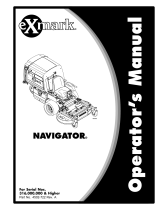
Maintenance
18
Replacing the Blower Belt
Squealing when the belt is rotating, blower slipping
causing frequent clogging of chute and blower, frayed
belt edges, burn marks and cracks are all signs of a
worn blower belt. Replace the blower belt if any of
these conditions are evident.
1. Stop the engine, remove the key and disconnect
the spark plug wire(s) from the spark plug(s).
2. Push up on the spring loaded idler pulley behind
PTO (power take off) gearbox to relax pressure
on blower belt (Fig. 28). Lock into frame slot,
refer to (Fig. 25).
3. Remove worn blower belt.
Note: On 25hp traction units: loosen, but do
not remove, blower mounting bolts for
clearance between engine oil cooler
and blower shaft bolt so belt clears.
4. Install new blower belt around PTO gearbox and
blower pulleys. Then push up on the idler and
place belt above idler pulley (Fig. 28).
5. Check that belt aligns with PTO, blower and
idler pulleys (Fig. 28).
1
2
3
4
m-3550
Figure 28
1. Blower belt
2. PTO Gearbox pulley
3. Blower pulley
4. Idler pulley
Cleaning the Hopper Full
Sensor
The hopper full sensor, inside the top right side of the
hopper, detects a beam of light from the transmitter to
the receiver. If the light beam is blocked the sensor
buzzer sounds. If the lenses are covered with
clippings or debris it may give false hopper full
signals and needs to be cleaned.
1. To clean the hopper full sensor dump the hopper
to remove grass clippings.
2. With the door open, wipe off the lenses of both
the transmitter and receiver with a soft cloth or
paper towel (Fig. 29).
3. To test the hopper full sensor for proper
operation turn the ignition key and PTO switch
to “ON”, but do not start the engine. Place a
piece of heavy cardboard in front of the
transmitter to block the light beam (Fig. 29). The
alarm buzzer should sound.
Note: Do not use your hand to test for proper
sensor operation as the light beam may
pass through or around your hand and
not properly activate the sensor.
1
2
m-3549
Figure 29
1. Transmitter 2. Receiver























